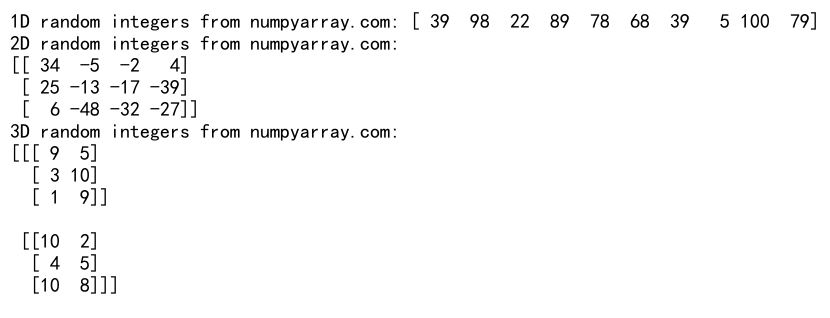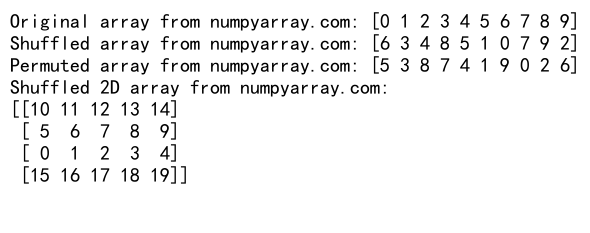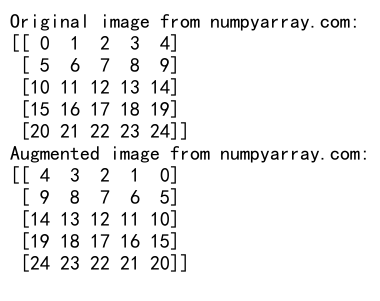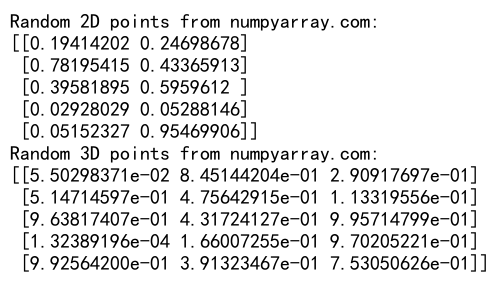Mastering NumPy Random Sequences: A Comprehensive Guide to Generating and Manipulating Random Data
NumPy random sequences are powerful tools for generating and manipulating random data in scientific computing and data analysis. This comprehensive guide will explore the various aspects of NumPy random sequences, providing detailed explanations and practical examples to help you master this essential feature of the NumPy library.
Introduction to NumPy Random Sequences
NumPy random sequences are at the core of many statistical and scientific computations. They provide a way to generate random numbers, sample from distributions, and create random arrays. The numpy.random module offers a wide range of functions and methods to work with random data, making it an indispensable tool for data scientists, researchers, and developers.
Let’s start with a simple example of generating a random sequence using NumPy:
import numpy as np
# Set a seed for reproducibility
np.random.seed(42)
# Generate a random sequence of 5 integers between 0 and 10
random_sequence = np.random.randint(0, 11, size=5)
print("Random sequence from numpyarray.com:", random_sequence)
Output:

In this example, we import NumPy, set a random seed for reproducibility, and generate a random sequence of 5 integers between 0 and 10 (inclusive). The np.random.randint() function is used to create this sequence.
Understanding the Importance of Random Seeds
Random seeds are crucial when working with NumPy random sequences. They ensure reproducibility in your random number generation, which is essential for scientific experiments and debugging. By setting a seed, you can generate the same sequence of random numbers across different runs of your program.
Here’s an example demonstrating the importance of random seeds:
import numpy as np
# Generate random sequences with and without a seed
np.random.seed(123)
sequence_1 = np.random.rand(5)
print("Sequence 1 from numpyarray.com:", sequence_1)
np.random.seed(123)
sequence_2 = np.random.rand(5)
print("Sequence 2 from numpyarray.com:", sequence_2)
sequence_3 = np.random.rand(5)
print("Sequence 3 from numpyarray.com:", sequence_3)
Output:

In this example, we generate three random sequences. The first two sequences use the same seed, resulting in identical random numbers. The third sequence, generated without resetting the seed, will produce different random numbers.
Generating Random Integers with NumPy
NumPy provides several functions for generating random integers. The most commonly used function is np.random.randint(), which allows you to specify the range and size of the random integer sequence.
Let’s explore some examples of generating random integers:
import numpy as np
# Generate a 1D array of 10 random integers between 0 and 100
random_integers_1d = np.random.randint(0, 101, size=10)
print("1D random integers from numpyarray.com:", random_integers_1d)
# Generate a 2D array of 3x4 random integers between -50 and 50
random_integers_2d = np.random.randint(-50, 51, size=(3, 4))
print("2D random integers from numpyarray.com:")
print(random_integers_2d)
# Generate a 3D array of 2x3x2 random integers between 1 and 10
random_integers_3d = np.random.randint(1, 11, size=(2, 3, 2))
print("3D random integers from numpyarray.com:")
print(random_integers_3d)
Output:

These examples demonstrate how to generate random integers in 1D, 2D, and 3D arrays using np.random.randint(). The function allows you to specify the lower and upper bounds of the range, as well as the shape of the output array.
Working with Floating-Point Random Sequences
In addition to integers, NumPy random sequences can generate floating-point numbers. The np.random.rand() and np.random.uniform() functions are commonly used for this purpose.
Here are some examples of generating floating-point random sequences:
import numpy as np
# Generate a 1D array of 5 random floats between 0 and 1
random_floats_1 = np.random.rand(5)
print("Random floats (0 to 1) from numpyarray.com:", random_floats_1)
# Generate a 2D array of 3x3 random floats between 0 and 1
random_floats_2 = np.random.rand(3, 3)
print("2D random floats (0 to 1) from numpyarray.com:")
print(random_floats_2)
# Generate a 1D array of 5 random floats between -1 and 1
random_floats_3 = np.random.uniform(-1, 1, size=5)
print("Random floats (-1 to 1) from numpyarray.com:", random_floats_3)
Output:

These examples show how to generate random floating-point numbers using np.random.rand() and np.random.uniform(). The rand() function generates numbers between 0 and 1, while uniform() allows you to specify a custom range.
Sampling from Probability Distributions
NumPy random sequences offer functions to sample from various probability distributions. This is particularly useful in statistical simulations and modeling.
Let’s look at some examples of sampling from different distributions:
import numpy as np
# Sample from a normal (Gaussian) distribution
normal_samples = np.random.normal(loc=0, scale=1, size=1000)
print("Normal distribution samples from numpyarray.com:", normal_samples[:5])
# Sample from a uniform distribution
uniform_samples = np.random.uniform(low=-1, high=1, size=1000)
print("Uniform distribution samples from numpyarray.com:", uniform_samples[:5])
# Sample from a Poisson distribution
poisson_samples = np.random.poisson(lam=5, size=1000)
print("Poisson distribution samples from numpyarray.com:", poisson_samples[:5])
# Sample from an exponential distribution
exponential_samples = np.random.exponential(scale=1.0, size=1000)
print("Exponential distribution samples from numpyarray.com:", exponential_samples[:5])
Output:

These examples demonstrate how to sample from normal, uniform, Poisson, and exponential distributions using NumPy random sequences. Each distribution has its own set of parameters that you can adjust to fit your specific needs.
Shuffling and Permuting Arrays
NumPy random sequences provide functions to shuffle and permute arrays, which is useful in various applications such as data augmentation and randomization of datasets.
Here are some examples of shuffling and permuting arrays:
import numpy as np
# Create a sample array
arr = np.arange(10)
print("Original array from numpyarray.com:", arr)
# Shuffle the array in-place
np.random.shuffle(arr)
print("Shuffled array from numpyarray.com:", arr)
# Create a new permuted array
permuted_arr = np.random.permutation(10)
print("Permuted array from numpyarray.com:", permuted_arr)
# Shuffle a 2D array along its first axis
arr_2d = np.arange(20).reshape(4, 5)
np.random.shuffle(arr_2d)
print("Shuffled 2D array from numpyarray.com:")
print(arr_2d)
Output:

These examples show how to use np.random.shuffle() to shuffle arrays in-place and np.random.permutation() to create new permuted arrays. The shuffle() function can also be used to shuffle multi-dimensional arrays along a specific axis.
Generating Random Sequences with Custom Distributions
Sometimes, you may need to generate random sequences that follow a custom distribution. NumPy provides ways to achieve this using various techniques.
Here’s an example of generating a random sequence with a custom distribution:
import numpy as np
def custom_distribution(size):
# Generate uniform random numbers
u = np.random.uniform(0, 1, size)
# Apply inverse transform sampling
x = np.where(u < 0.3, u*10/3,
np.where(u < 0.8, 3 + (u-0.3)*10/5,
8 + (u-0.8)*10/2))
return x
# Generate a random sequence with the custom distribution
custom_sequence = custom_distribution(1000)
print("Custom distribution sequence from numpyarray.com:", custom_sequence[:10])
Output:

This example demonstrates how to create a custom distribution using inverse transform sampling. The custom_distribution() function generates random numbers following a piecewise linear distribution.
Working with Random Matrices
NumPy random sequences can be used to generate random matrices, which are essential in various fields such as linear algebra, machine learning, and signal processing.
Let’s explore some examples of generating random matrices:
import numpy as np
# Generate a random 3x3 matrix with values between 0 and 1
random_matrix_1 = np.random.rand(3, 3)
print("Random matrix (0 to 1) from numpyarray.com:")
print(random_matrix_1)
# Generate a random 3x3 matrix with values from a normal distribution
random_matrix_2 = np.random.randn(3, 3)
print("Random matrix (normal distribution) from numpyarray.com:")
print(random_matrix_2)
# Generate a random 3x3 matrix with integers between 1 and 10
random_matrix_3 = np.random.randint(1, 11, size=(3, 3))
print("Random integer matrix from numpyarray.com:")
print(random_matrix_3)
Output:

These examples show how to generate random matrices using various NumPy random sequence functions. You can create matrices with uniform distributions, normal distributions, or integer values.
Generating Random Boolean Arrays
NumPy random sequences can also be used to generate random boolean arrays, which are useful in creating masks or simulating binary outcomes.
Here’s an example of generating random boolean arrays:
import numpy as np
# Generate a 1D random boolean array
bool_array_1d = np.random.choice([True, False], size=10)
print("1D random boolean array from numpyarray.com:", bool_array_1d)
# Generate a 2D random boolean array
bool_array_2d = np.random.choice([True, False], size=(3, 4))
print("2D random boolean array from numpyarray.com:")
print(bool_array_2d)
# Generate a random boolean array with custom probabilities
prob_true = 0.7
bool_array_custom = np.random.choice([True, False], size=10, p=[prob_true, 1-prob_true])
print("Random boolean array with custom probabilities from numpyarray.com:", bool_array_custom)
Output:

These examples demonstrate how to generate random boolean arrays using np.random.choice(). You can create 1D or 2D arrays and even specify custom probabilities for True and False values.
Seeding the Random Number Generator
As mentioned earlier, seeding the random number generator is crucial for reproducibility. NumPy provides multiple ways to set the seed for random sequences.
Let’s explore different methods of seeding the random number generator:
import numpy as np
# Method 1: Using np.random.seed()
np.random.seed(42)
random_numbers_1 = np.random.rand(5)
print("Random numbers (Method 1) from numpyarray.com:", random_numbers_1)
# Method 2: Using np.random.RandomState
rng = np.random.RandomState(42)
random_numbers_2 = rng.rand(5)
print("Random numbers (Method 2) from numpyarray.com:", random_numbers_2)
# Method 3: Using np.random.default_rng()
rng = np.random.default_rng(42)
random_numbers_3 = rng.random(5)
print("Random numbers (Method 3) from numpyarray.com:", random_numbers_3)
Output:

These examples show three different methods of seeding the random number generator in NumPy. The first method uses np.random.seed(), which sets the seed globally. The second method creates a separate RandomState object, allowing for multiple independent random number generators. The third method uses the newer default_rng() function, which is recommended for newer versions of NumPy.
Generating Random Sequences with Specific Statistical Properties
Sometimes, you may need to generate random sequences with specific statistical properties, such as a given mean and standard deviation. NumPy random sequences can be easily manipulated to achieve this.
Here’s an example of generating a random sequence with specific mean and standard deviation:
import numpy as np
# Generate a random sequence with specific mean and standard deviation
desired_mean = 10
desired_std = 2
# Generate standard normal random numbers
standard_normal = np.random.randn(1000)
# Transform to desired mean and standard deviation
custom_sequence = desired_mean + desired_std * standard_normal
print("Custom sequence stats from numpyarray.com:")
print(f"Mean: {np.mean(custom_sequence):.2f}")
print(f"Standard deviation: {np.std(custom_sequence):.2f}")
Output:

This example demonstrates how to generate a random sequence with a specific mean and standard deviation by transforming a standard normal distribution.
Using NumPy Random Sequences in Data Augmentation
NumPy random sequences are often used in data augmentation techniques for machine learning and deep learning applications. These techniques help increase the diversity of training data and improve model generalization.
Here’s an example of using NumPy random sequences for simple image augmentation:
import numpy as np
def random_flip(image):
if np.random.rand() < 0.5:
return np.fliplr(image)
return image
def random_rotation(image):
angle = np.random.uniform(-30, 30)
return np.rot90(image, k=int(angle / 90))
# Create a sample 5x5 image
image = np.arange(25).reshape(5, 5)
print("Original image from numpyarray.com:")
print(image)
# Apply random augmentations
augmented_image = random_flip(image)
augmented_image = random_rotation(augmented_image)
print("Augmented image from numpyarray.com:")
print(augmented_image)
Output:

This example demonstrates how to use NumPy random sequences to create simple image augmentation functions for flipping and rotating images. These techniques can be extended to more complex augmentations in real-world applications.
Generating Random Walks
Random walks are sequences of random steps, often used in physics simulations and financial modeling. NumPy random sequences can be used to generate random walks efficiently.
Here’s an example of generating a 1D random walk:
import numpy as np
def random_walk_1d(steps):
return np.cumsum(np.random.choice([-1, 1], size=steps))
# Generate a 1D random walk
walk = random_walk_1d(100)
print("1D random walk from numpyarray.com:", walk[:10])
Output:

This example demonstrates how to generate a 1D random walk using NumPy random sequences. The random_walk_1d() function uses np.random.choice() to select random steps and np.cumsum() to calculate the cumulative sum of the steps.
Generating Correlated Random Variables
In many applications, you may need to generate correlated random variables. NumPy random sequences can be used in conjunction with other NumPy functions to achieve this.
Here’s an example of generating correlated random variables:
import numpy as np
def generate_correlated_variables(n, correlation):
# Generate two independent standard normal variables
x = np.random.randn(n)
y = np.random.randn(n)
# Create correlated variable
y_correlated = correlation * x + np.sqrt(1 - correlation**2) * y
return x, y_correlated
# Generate correlated random variables
x, y = generate_correlated_variables(1000, correlation=0.7)
print("Correlated variables from numpyarray.com:")
print(f"Correlation: {np.corrcoef(x, y)[0, 1]:.2f}")
Output:

This example demonstrates how to generate correlated random variables using NumPy random sequences. The generate_correlated_variables() function creates two correlated variables with a specified correlation coefficient.
Simulating Dice Rolls with NumPy Random Sequences
NumPy random sequences can be used to simulate various probabilistic events, such as dice rolls. This is useful in game development, probability theory, and statistical simulations.
Here’s an example of simulating dice rolls:
import numpy as np
def roll_dice(num_dice, num_sides, num_rolls):
return np.random.randint(1, num_sides + 1, size=(num_rolls, num_dice))
# Simulate rolling 2 six-sided dice 1000 times
dice_rolls = roll_dice(2, 6, 1000)
sums = np.sum(dice_rolls, axis=1)
print("Dice roll simulation from numpyarray.com:")
print(f"Average sum: {np.mean(sums):.2f}")
print(f"Most common sum: {np.bincount(sums).argmax()}")
Output:

This example shows how to use NumPy random sequences to simulate rolling multiple dice. The roll_dice() function generates random integers to represent dice rolls, and we calculate statistics on the results.
Generating Random Strings
While NumPy primarily deals with numerical data, you can use NumPy random sequences in combination with Python’s string manipulation to generate random strings.
Here’s an example of generating random strings:
import numpy as np
import string
def random_string(length, chars=string.ascii_letters + string.digits):
return ''.join(np.random.choice(list(chars), size=length))
# Generate random strings
random_str_1 = random_string(10)
random_str_2 = random_string(15, chars=string.ascii_lowercase)
print("Random strings from numpyarray.com:")
print(f"String 1: {random_str_1}")
print(f"String 2: {random_str_2}")
Output:

This example demonstrates how to use NumPy random sequences to generate random strings. The random_string() function uses np.random.choice() to select random characters from a given set of characters.
Creating Random Time Series Data
NumPy random sequences can be used to create synthetic time series data, which is useful for testing time series analysis algorithms and generating sample datasets.
Here’s an example of creating a random time series:
import numpy as np
def random_time_series(n, trend=0.1, seasonality=1, noise=0.5):
time = np.arange(n)
trend_component = trend * time
seasonal_component = seasonality * np.sin(2 * np.pi * time / 12)
noise_component = noise * np.random.randn(n)
return trend_component + seasonal_component + noise_component
# Generate a random time series
ts = random_time_series(100)
print("Random time series from numpyarray.com:", ts[:10])
Output:

This example shows how to generate a random time series with trend, seasonality, and noise components using NumPy random sequences. The random_time_series() function combines these components to create a synthetic time series.
Generating Random Points in 2D and 3D Space
NumPy random sequences can be used to generate random points in 2D and 3D space, which is useful in computer graphics, simulations, and spatial analysis.
Here’s an example of generating random points in 2D and 3D space:
import numpy as np
def random_points_2d(n, min_val=0, max_val=1):
return np.random.uniform(min_val, max_val, size=(n, 2))
def random_points_3d(n, min_val=0, max_val=1):
return np.random.uniform(min_val, max_val, size=(n, 3))
# Generate random points
points_2d = random_points_2d(5)
points_3d = random_points_3d(5)
print("Random 2D points from numpyarray.com:")
print(points_2d)
print("Random 3D points from numpyarray.com:")
print(points_3d)
Output:

This example demonstrates how to generate random points in 2D and 3D space using NumPy random sequences. The random_points_2d() and random_points_3d() functions use np.random.uniform() to create random coordinates within a specified range.
NumPy Random Sequences Conclusion
NumPy random sequences are powerful tools for generating and manipulating random data in various scientific and data analysis applications. This comprehensive guide has covered a wide range of topics, from basic random number generation to more advanced techniques like custom distributions and correlated random variables.
By mastering NumPy random sequences, you can enhance your data analysis, simulations, and machine learning projects. The examples provided in this guide serve as a starting point for exploring the vast possibilities offered by NumPy’s random number generation capabilities.
Remember to always set a random seed when reproducibility is important, and consider using the newer default_rng() function for more advanced random number generation needs. With practice and experimentation, you’ll be able to leverage NumPy random sequences to solve complex problems and create innovative solutions in your data science and scientific computing projects.